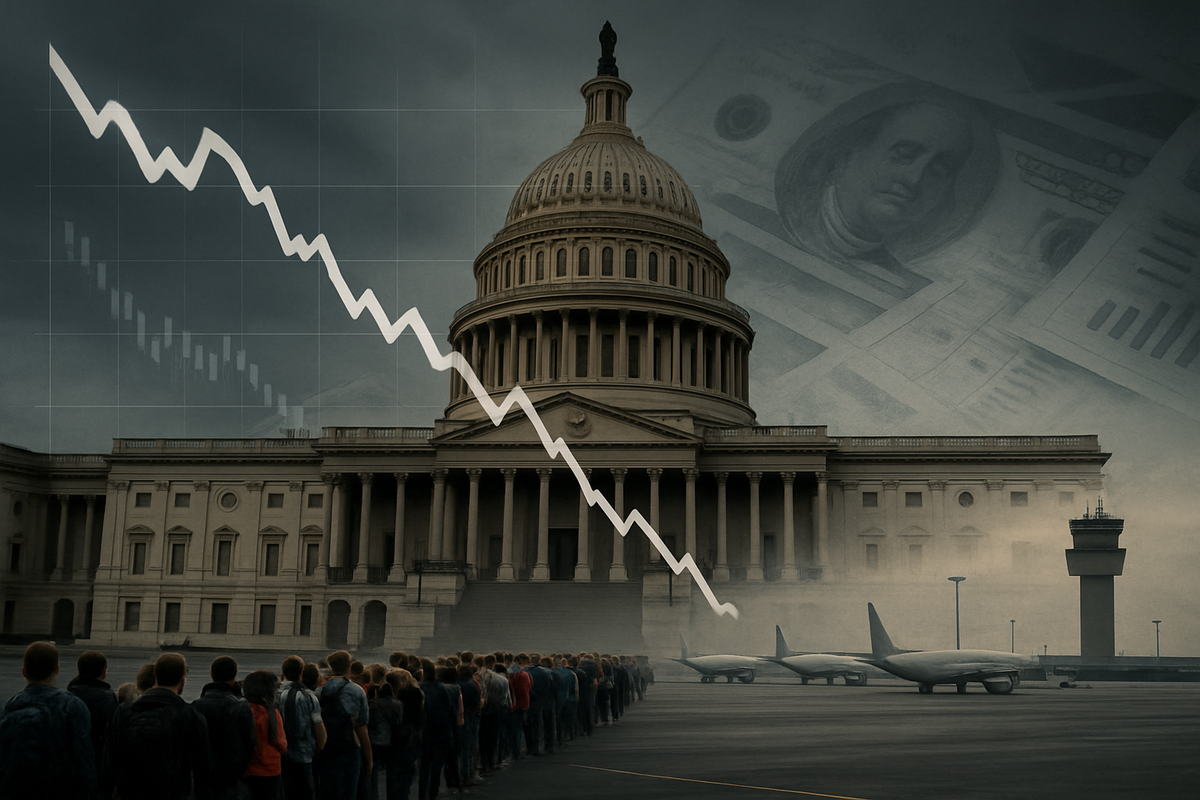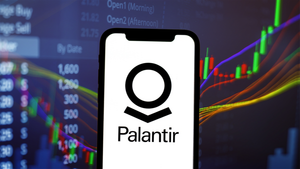
Washington D.C., October 8, 2025 – The U.S. federal government remains in the throes of a shutdown, now entering its second week, as lawmakers in Washington continue to grapple with a stalemate over federal funding for Fiscal Year 2026. This ongoing budgetary impasse, which commenced on October 1, 2025, is sending ripples of uncertainty across the nation's economy and financial markets, with particular strain evident in critical infrastructure like airports, where essential personnel are working without pay.
The immediate implications are widespread: hundreds of thousands of federal employees are furloughed, vital government services are suspended, and the nation's economic data collection has effectively ceased. While financial markets have historically shown resilience to such disruptions, the prolonged nature of this shutdown, coupled with existing economic anxieties, raises concerns about its potential for deeper, more lasting impacts on businesses and the broader public.
The Standoff: A Battle Over Budget and Policy
The current shutdown is the culmination of weeks of intense, yet ultimately failed, negotiations between the Republican-controlled House, the Democratic-led Senate, and the Executive Branch. The U.S. federal government's fiscal year officially ended on September 30, 2025, without the passage of the customary 12 annual appropriations bills or a temporary Continuing Resolution (CR) to fund government operations.
The primary sticking point in this hypothetical scenario revolves around disagreements over healthcare policy. Democrats have reportedly insisted that any funding measure must include an extension of expiring Affordable Care Act (ACA) tax credits, a position staunchly opposed by Republicans, who favor addressing these provisions separately or rejecting them entirely. The House, led by Speaker Mike Johnson (R-La.), passed a "clean" short-term funding resolution that would have funded the government until November 21 without addressing the Democratic healthcare demands. However, this bill failed to pass in the Senate, where Senate Minority Leader Chuck Schumer (D-NY) and other Democrats held firm, rejecting it. Senate Majority Leader John Thune (R-SD) has attempted to broker compromises, but multiple proposals have failed to secure the necessary 60-vote threshold.
Key players include President Donald Trump, who has reportedly threatened permanent job cuts among federal workers, though he has also signaled a willingness to negotiate on healthcare subsidies. On the legislative front, Speaker Johnson and Leader Thune represent the Republican stance, while Leader Schumer and other prominent Democrats, such as Senator Tim Kaine and Senator Angus King, are united in their demand for healthcare subsidy extensions.
Initial reactions from financial markets have been a mix of volatility and historical resilience. The CBOE Volatility Index saw an increase at the shutdown's onset, indicating a "risk-off" sentiment. However, equity markets, like the S&P 500, have historically demonstrated a remarkable ability to recover quickly from shutdowns, with some analyses even showing positive returns during such periods. Notably, the S&P 500 reportedly hit new record highs despite the onset of this hypothetical shutdown, suggesting investors may view it as a temporary disruption. U.S. Treasury bonds have rallied as investors sought safe-haven assets, leading to a drop in yields. A significant concern for markets is the suspension of critical economic data releases, creating a "data drought" that complicates investment decisions and Federal Reserve policy deliberations. Each week of a shutdown is estimated to reduce annualized U.S. GDP growth by approximately 0.1 to 0.2 percentage points.
The impact on airport operations has been particularly acute. Transportation Security Administration (TSA) agents and air traffic controllers (ATC), deemed essential employees, are required to work without pay. As the shutdown lengthens, the financial pressure on these workers is leading to increased absenteeism, including "sick-outs," reminiscent of the 2018-2019 shutdown. Reports as of October 7, 2025, indicate flight delays at major airports like Newark Liberty International (NASDAQ: LUV), Denver International (NYSE: DAL), and Hollywood Burbank (NASDAQ: AAL) due to ATC shortages. Non-essential functions of the Federal Aviation Administration (FAA), such as some inspections and long-term planning, are halted, disrupting the hiring and training of new air traffic controllers and exacerbating existing staffing shortages. The Transportation Secretary has warned that flights could be grounded if safety issues arise from staffing problems, posing a direct threat to travelers and the financial health of airlines.
Companies on the Brink: Winners and Losers in a Shutdown Economy
An ongoing U.S. government shutdown creates a bifurcated market, severely impacting companies with direct federal ties while others may remain relatively insulated or even indirectly benefit from a flight to safety.
Government Contractors and Defense Companies: These firms are at the forefront of the negative impact. Companies like Lockheed Martin (NYSE: LMT), Raytheon Technologies (NYSE: RTX), and Northrop Grumman (NYSE: NOC), while often having large, existing contracts, face delays in new contract awards, modifications, and payments for ongoing work. Smaller and mid-sized contractors, in particular, are highly vulnerable due to their reliance on a steady flow of government contracts and often lack the financial cushion to absorb payment delays or project stoppages. Many federal contractor employees are not guaranteed back pay, leading to severe cash flow problems for these businesses. The furloughing of Department of Defense civilian employees also hinders contractors' ability to perform work or obtain necessary approvals.
Aerospace and Aviation: Beyond the direct impact on airport operations, the broader aerospace sector faces challenges. Delays in export licenses, due to the closure of departments like State and Commerce, can hold up deliveries to international customers, affecting companies like Boeing (NYSE: BA). Research and development projects at federal agencies like NASA and the FAA are suspended, delaying critical technology development. Airlines such as Delta Air Lines (NYSE: DAL), United Airlines Holdings (NASDAQ: UAL), and American Airlines Group (NASDAQ: AAL) suffer directly from reduced passenger demand, flight disruptions caused by ATC shortages, and longer security lines.
Travel and Hospitality: The shutdown creates a ripple effect across the travel industry. National parks, museums, and other federally managed attractions are closed, directly impacting tourism. Hotels, rental car companies like Enterprise Holdings (Private), and tour operators, especially those near federal tourist destinations, experience reduced visitor numbers and discretionary spending. The U.S. Travel Association estimates that a shutdown costs the travel economy $1 billion every week. Delays in processing passports and visas further deter international travel.
Companies Requiring Regulatory Approvals: Sectors heavily reliant on federal regulatory bodies face significant bottlenecks. Biotechnology and pharmaceutical companies like Pfizer (NYSE: PFE) or Moderna (NASDAQ: MRNA) may see delays in drug trial approvals from the Food and Drug Administration (FDA). Financial firms requiring new product approvals or IPO reviews from the Securities and Exchange Commission (SEC) will experience slowdowns. Energy companies seeking environmental permits from the Environmental Protection Agency (EPA) will also face delays. This regulatory paralysis can stall innovation and investment across various industries.
Potential "Winners" (Limited and Indirect): While direct positive impacts are rare, some companies might experience indirect benefits. Defensive sectors like consumer staples (e.g., Procter & Gamble (NYSE: PG)) and utilities (e.g., NextEra Energy (NYSE: NEE)) often show more resilience during periods of economic uncertainty as investors seek stability. Companies offering alternative solutions to suspended government services in niche areas might see temporary demand increases. However, these are generally limited and do not offset the broader economic drag.
Wider Significance: A Blow to Confidence and Global Standing
The ongoing U.S. government shutdown is more than a domestic budgetary squabble; it carries profound wider significance, impacting the nation's economic trajectory, international standing, and policy landscape.
Economic Headwinds: The shutdown exacerbates existing economic anxieties. While the U.S. economy was generally poised for continued growth in 2025, albeit at a decelerating pace, the shutdown introduces significant uncertainty. The estimated 0.1-0.2 percentage point reduction in annualized GDP growth per week, along with a "data blackout" from delayed economic reports (e.g., jobs, CPI), complicates the Federal Reserve's ability to make informed monetary policy decisions, especially regarding anticipated interest rate cuts. The financial strain on hundreds of thousands of federal employees and over a million federal contractors directly impacts consumer spending and local economies, with some economic losses potentially becoming permanent, as evidenced by the $3 billion permanently lost during the 2018-2019 shutdown.
Ripple Effects on International Relations: A prolonged shutdown undermines global confidence in U.S. governance and fiscal stability. Economic rivals may perceive the political gridlock as a sign of weakness, potentially challenging U.S. leadership. Allies and partners face disruptions to joint projects, diplomatic engagements, and military cooperation, creating "unnecessary risk to U.S. citizens both at home and abroad." Delays in export licenses, sanctions compliance activities, and foreign investment reviews by agencies like the Bureau of Industry and Security (BIS) and the Directorate of Defense Trade Controls (DDTC) hinder international trade and investment. The Office of the U.S. Trade Representative (USTR) may continue essential activities, but the broader diplomatic apparatus suffers from reduced support and staffing.
Regulatory and Policy Paralysis: The shutdown creates immediate regulatory bottlenecks. Agencies like the SEC, FDA, and EPA operate with minimal staff, leading to significant slowdowns or complete halts in approvals for IPOs, drug trials, environmental permits, and M&A reviews. This directly affects innovation and growth in critical sectors. The Committee on Foreign Investment in the United States (CFIUS) will toll deadlines, delaying clearances for foreign investments. Furthermore, the shutdown can stall cybersecurity initiatives and state/local cybersecurity grant programs, impacting national security. A notable and concerning development in this hypothetical scenario is the threat from the Office of Management and Budget (OMB) for federal agencies to draft plans for permanent staff cuts, moving beyond temporary furloughs to potential "Reduction in Force" (RIF) notices, which would have longer-lasting consequences for government capacity.
Historical Precedents: U.S. government shutdowns are not new. Since 1980, there have been numerous funding gaps, with several resulting in significant shutdowns. Notable examples include:
- 1995-1996 Shutdowns (21 days total): During President Bill Clinton's administration, disputes with a Republican-controlled Congress over spending levels led to two shutdowns.
- 2013 Shutdown (16 days): Under President Obama, a standoff over the Affordable Care Act (ACA) led to a 16-day shutdown, costing an estimated 0.3 percentage points from annual GDP.
- 2018-2019 Shutdown (35 days): The longest in U.S. history, under President Donald Trump, over border wall funding. This partial shutdown reduced GDP growth and resulted in an estimated $3 billion in permanent economic loss.
Historically, while the immediate economic pain is real, markets tend to recover. However, the cumulative effect of repeated shutdowns can erode long-term confidence and create a perception of political instability.
What Comes Next: Paths to Resolution and Strategic Shifts
The trajectory of the ongoing U.S. government shutdown remains uncertain, with a range of short-term and long-term possibilities, demanding strategic adaptations from businesses and close monitoring from investors.
Short-Term Possibilities: In the immediate future, the most likely path to resolution involves the passage of a short-term Continuing Resolution (CR). This temporary funding measure would allow the government to reopen and resume full operations, buying lawmakers more time to negotiate a comprehensive budget agreement. However, achieving this requires bipartisan consensus, particularly the 60 votes needed in the Senate, which gives the minority party significant leverage. Without a CR, the shutdown will continue to deepen its impact, leading to further absenteeism among essential workers, more widespread service disruptions, and increasing economic drag.
Long-Term Possibilities: A prolonged shutdown, extending beyond several weeks, would compound economic damage, leading to more significant and potentially unrecoverable losses. It would further erode public, consumer, and investor confidence in U.S. governance and fiscal stability, making long-term business planning more difficult. The threat of permanent job cuts within the federal workforce, if realized, would have severe and lasting consequences on the labor market and consumer spending. The current political climate, deeply divided over contentious issues like healthcare subsidies, suggests that a protracted standoff is a real possibility, as evidenced by the 35-day shutdown of 2018-2019.
Potential Scenarios for Resolution:
- Bipartisan Compromise: The most desirable outcome involves significant negotiation and compromise from both Republicans and Democrats on core issues, such as the extension of ACA premium tax credits and proposed Medicaid cuts. This would likely involve concessions from both sides.
- Increased Pressure: As the shutdown lengthens and the economic costs mount, growing public dissatisfaction and financial hardship on furloughed workers and businesses often compel lawmakers to find a resolution.
- Protracted Standoff: A less optimistic scenario is a prolonged shutdown if neither party is willing to concede, leading to a sustained period of government dysfunction and economic uncertainty.
Strategic Adaptations for Businesses: Businesses, especially those with federal ties, must implement robust strategies to mitigate the impact:
- Build Financial Buffers: Maintain strong cash reserves and access to credit lines to withstand delayed federal payments.
- Diversify Revenue Streams: Reduce over-reliance on government contracts by exploring private sector or international markets.
- Proactive Communication: Transparently communicate potential impacts on earnings, regulatory approvals, and supply chains to investors and stakeholders.
- Assess Operational Dependencies: Identify all critical functions reliant on federal agencies (e.g., permits, inspections, data) and develop contingency plans for delays or cessations.
- Scenario Planning: Prepare for various shutdown durations and understand their impact on cash flow, payroll, and operations.
Emerging Market Opportunities or Challenges:
- Challenges: Continued economic growth impairment, market volatility, and sector-specific vulnerabilities (defense, government contractors, travel, biotech, financial services). The "data blackout" will complicate Federal Reserve policy.
- Opportunities: Defensive assets like utilities and consumer staples may show resilience. Significant market dips could present buying opportunities for long-term investors, as historical data suggests markets tend to "shrug off" shutdowns over time. Businesses with diversified, non-government-dependent revenue streams may find themselves relatively insulated.
Wrap-Up: Navigating Uncertainty in a Politically Charged Market
The ongoing U.S. government shutdown as of October 8, 2025, underscores the inherent fragility of a market heavily influenced by political consensus. While historical data suggests that broad equity markets often demonstrate resilience to such events, recovering once a resolution is in sight, the immediate economic pain and uncertainty are undeniable.
Key Takeaways: The shutdown has immediately impacted hundreds of thousands of federal employees and over a million federal contractors, leading to financial hardship and reduced consumer spending. Critical government services are curtailed, and the flow of essential economic data has been disrupted, creating a fog of uncertainty for investors and policymakers alike. Airports are a visible casualty, with essential staff working without pay, leading to operational strains and potential safety concerns. The broader significance lies in the erosion of confidence in U.S. governance, potential damage to international standing, and a paralysis of regulatory functions across numerous industries.
Market Moving Forward: Investors should brace for continued short-term market volatility. While the S&P 500 has historically shown an ability to recover from shutdowns, the longer this one persists, the greater the risk of more significant and lasting economic impacts. The lack of reliable economic data will make it challenging for the Federal Reserve to guide monetary policy, potentially adding to market jitters.
Lasting Impact: While many direct economic losses from shutdowns are eventually recovered, a portion can be permanently lost, as seen in past events. More importantly, repeated shutdowns can gradually erode trust in U.S. fiscal governance, potentially creating a persistent, albeit small, risk premium in U.S. assets. This could affect the nation's credit rating and its perceived reliability as an international economic partner.
What Investors Should Watch For: In the coming months, investors should closely monitor:
- Shutdown Duration and Resolution: Any credible signals of negotiation progress or a swift resolution will likely trigger a market rally.
- Economic Data: Once the shutdown ends, a deluge of backlogged data will be released, which could cause significant market movements.
- Federal Reserve Commentary: Pay attention to Fed officials' statements regarding monetary policy in light of the economic uncertainty.
- Consumer Sentiment: A sustained decline in consumer confidence could signal broader economic weakness.
- Government-Dependent Sectors: Keep a close eye on the earnings reports and outlooks of federal contractors, defense companies, and the travel industry, as these will be most directly affected. Companies like Boeing (NYSE: BA), Lockheed Martin (NYSE: LMT), Delta Air Lines (NYSE: DAL), and smaller federal IT contractors will be particularly sensitive to the duration and resolution of the shutdown.
This content is intended for informational purposes only and is not financial advice.




